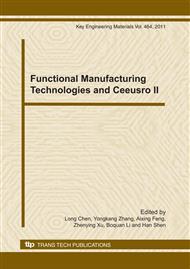p.712
p.717
p.721
p.725
p.730
p.736
p.741
p.745
p.749
The Pyrocarbon Deposition Techniques of Mechanical Heart Valve Prostheses
Abstract:
The structure and property of pyrocarbon varies widely with different deposition conditions. The isotropic carbon which can only been deposited in the bed of fluidized particles is very important in biomedical fields, for instance, it is often used as the coating of artificial heart valve components. The deposition of isotropic pyrocarbon containing silicon is experimented in fluidized bed over a wide range of deposition conditions. The results show that bed temperature influences strongly average coating rate, coating density, silicon content and coating micro-hardness. Propane concentration has a much effect on coating density, carbon matrix density and isotropic characteristics. Total gas flow rate and inlet dimension of fluidized bed affect the formation of fluidized bed.
Info:
Periodical:
Pages:
749-752
Citation:
Online since:
January 2011
Authors:
Price:
Сopyright:
© 2011 Trans Tech Publications Ltd. All Rights Reserved
Share:
Citation:


